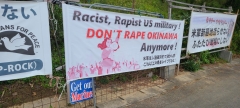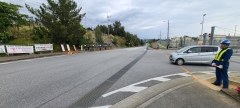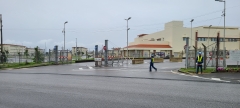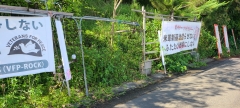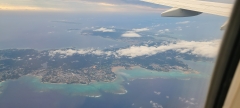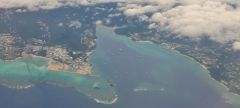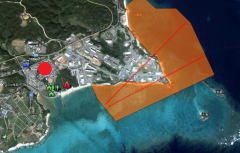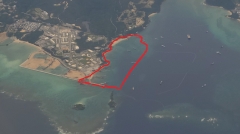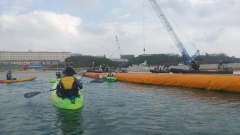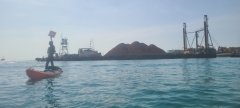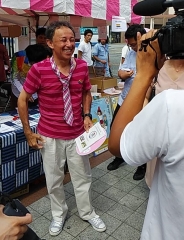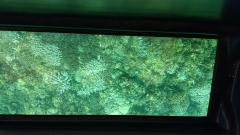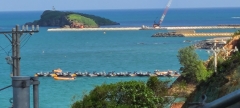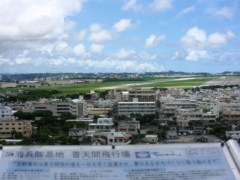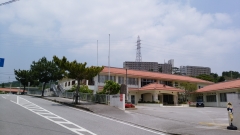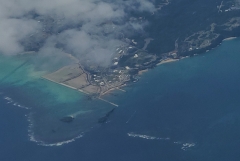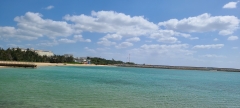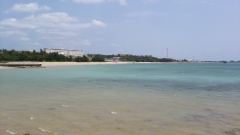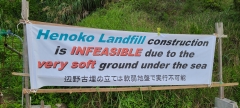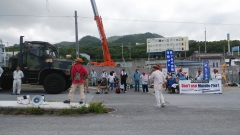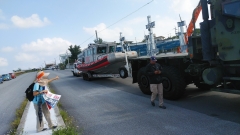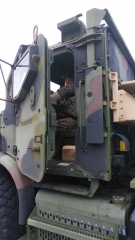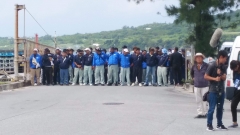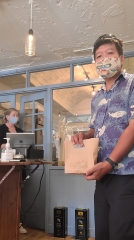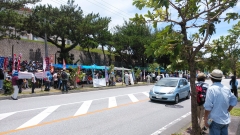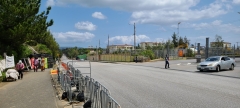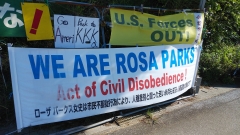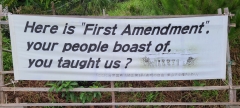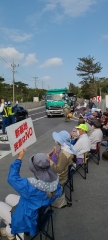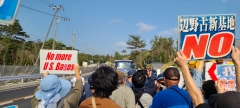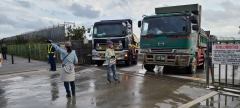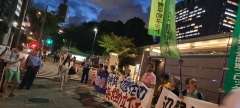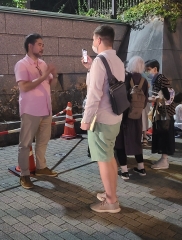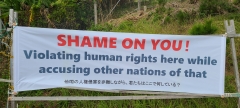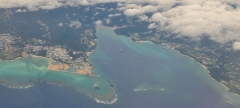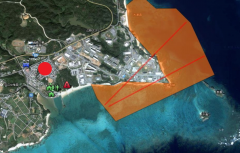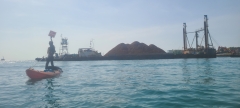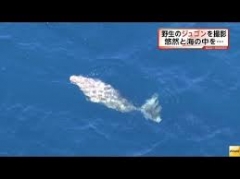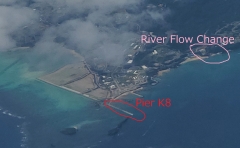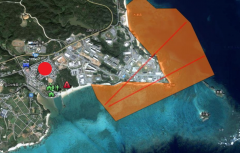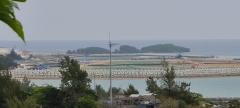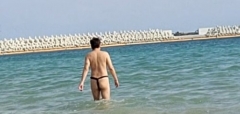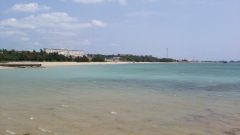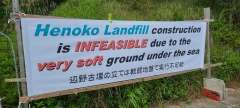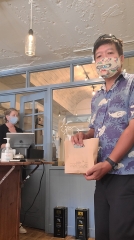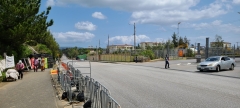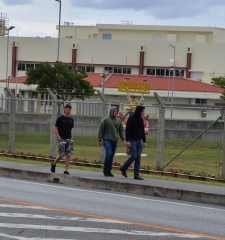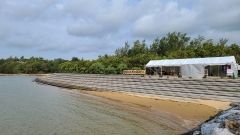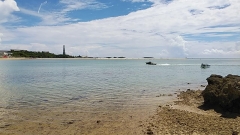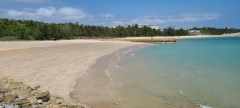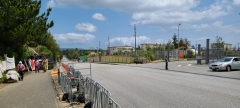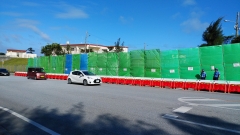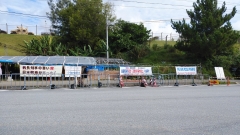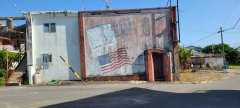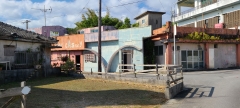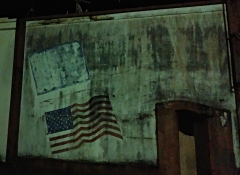05 August 2025
Dear US Marine servicemember who destroyed the message banner at Camp Schwab, Okinawa
Here I post my letter to the young US Marine serviceman who destoryed the message banner at USMC Camp Schwab in Henoko, Nago city, Okinawa prefecture.
This is the message I and other activists created and placed since last fall.
It was placed facing the entry gate to the camp for the protest activity.
But last April the banner was destroyed and taken away.
It was a crime act. But I decided not to file the damage report to police this time as mentioned in following letter texts.
I handed the letter over to the police to give it to the serviceman.
Some of the texts are altered in order not to disclose the offender's identity. The incident and the letter were reported to the local news media as well as some of national news outlets.
-----------------------------------------------------------------------------------------------------------------------------
Dear Sir,
I am Masagata, one of the contributors of creation and setting up the banner you destroyed and took away from where it was picketed near the Camp Schwab gate. I live in Tokyo but sometimes stay in Okinawa to join the protest against the construction of planned runways. I am much older than you like your father. When I was your age, I lived in the US as a college student.
I heard the reason that you destroyed the banner from the police. You were incited by the word “RAPE” on the banner because your closest person was a rape victim. I am saddened to hear that. I sympathized with you. Therefore, this time I will not file a damage report to the police nor demand the compensation for the damage.
But remember what you did was illegal. Some might say our setting up the banner in that place is unlawful as well but that is considered to be an act of freedom of expression ensured by the Japanese constitution like the first amendment of your country’s constitution.
“RAPE” in that banner does not only mean physical rape incidents committed by the US servicemembers in Okinawa but destruction of the environment of the island caused by the ongoing construction at your serving place. For details, please read my letter to the US government.
Instead of charging you with a crime, I ask you to escalate our message as protestors to your supervisors and your neighbors so that more people will know the pain locals are feeling.
I will post this letter on my blogsite to let the world know what’s going on in Okinawa without mentioning your name.
I heard you are leaving Okinawa soon. I wish you best luck in your future.
Best regards,
15:37 Posted in Ecology, Japan News, Media, Politics, Society, US-Japan relationship, USA issues | Permalink | Comments (0) | Tags: military, okinawa
11 June 2024
Dear US Government re: request for stopping the USMC new base construction in Okinawa, Japan
Update version of the letter below is posted on November 10, 2025. See this page.
Dear US President Biden, Congressmembers, Senators and other decision makers of the issue,
My name is MASAGATA, a Japanese man living in Tokyo. I used to study at San Francisco State University, where I majored in International Relations. I am now working as a translator using the English knowledge I acquired in the US.
I am writing this letter to urge US government to discontinue and terminate current ongoing landfill construction to build a new US Marine base runways at Camp Schwab, Henoko, Nago city, Okinawa prefecture.
This is the modified version of the letter I sent US Congress members and Senators in a joint Armed Forces Committee which was finalizing National Defense Authority Act several years ago. I added updated information to it.
I, myself visited Okinawa many times. I’ve been engaged in this issue since 2009.
The below is main points I would like to describe in this letter.
- What has been going on up until now
- Locals strongly oppose the new base construction
- Precious wildlife and ecosystem are threatened
- Technically, physically infeasible project
- America is held accountable for this stupid project
- Growing doubts about US commitment to Japan’s defense
- Your Servicemen & women and American residents are facing hostility in Okinawa
- Russia and China are watching what America is doing in Okinawa
9. KEEP YOUR HONOR CLEAN
Some of the below photos can be enlarged by clicking on them.
----------------------------------------------
- What has been going on up until now
Okinawa is chain of islands and southernmost prefecture below mainland Japan. The climate is subtropical and blessed with abundance of nature surrounded by coral reef. It is 3 hour-flight from Tokyo and very famous for marine leisure tourism just like Hawaii. In fact Okinawa went through the same path as Hawaii did.
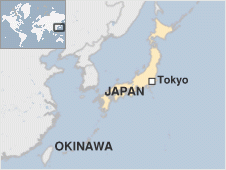
Until the end of 19th century it was an independent kingdom but annexed by mainland force. In 1945 US forces occupied Okinawa and then Okinawa has been occupied until 1972, which was 20 years after the mainland Japan regained sovereignty and was the only place that experienced ground battles within Japan, causing 200,000 civilian casualties during WW II.
The current population of Okinawa prefecture is 1.45 million.
In 1996 both the American and Japanese governments agreed to relocate US Marine Corp. Futenma base in Ginowan City, Okinawa to Camp Schwab to get away from the densely populated area around Futenma, together with some of Futenma capabilities to relocate to Guam in the Pacific.
Camp Schwab is on the coastline of Okinawa island, in an area called Henoko.
The relocation plan includes reclamation of the sea to build a new base that consists of two runways and ports expanding existing facility. Schwab is located in between Henoko coast (left) and Oura Bay (right) as you see in the photo taken on May 20, 2021.
The below marked area is the planned reclamation area on Henoko coast.
The two lines are runways built on the reclamation area. The big dot point on the left is residential area next to the Camp Schwab.
The below is the comparison to the current status with the reclamation plan.
- Locals strongly oppose the new base construction
Since the plan was announced, locals and activists from all over Japan have been protesting the new base construction by holding referendums, supporting candidates of mayoral and gubernatorial election, and municipal assembly members, who oppose the construction, as well as sit-in demonstration at the gate of Camp Schwab and kayaking at the landfilling site as civil disobedience act. Until now, tens of protesters were arrested and injured by police at the gate or coast of Camp Schwab.
In September2018, Okinawans elected Denny Tamaki as a Governor of Okinawa after death of then governor Takeshi Onaga, who was opposed to the new base construction. Mr. Tamaki succeeded the will of Onaga and won the election. He was formerly a Diet, Japan’s National Assembly member.
His father was a US Marine serviceman stationed in Okinawa and mother was Okinawan native. It was first time in Japan that a racially mixed man was elected as governor of one Prefecture. He proved that Japan is no longer homogeneous population and the nation can tolerate racial diversity. (Next photo is Mr. Okinawa Governor Denny Tamaki.
In February, 2019, Okinawa held referendum to ask whether locals approve or oppose the landfill construction at Henoko sea for the construction of a new United States Marine Corps base. The outcome was that 71% of voters oppose the new base construction.
The main reason to oppose the relocation of Futenma is the relocation takes place within Okinawa island, not outside of Okinawa prefecture, which cannot reduce burden on Okinawans' lives.
In September 2022, Tamaki’s second gubernatorial election was held and he won again overwhelmingly defeating other two candidates.
After the election, nationwide opinion poll was conducted by KYODO NEWS agency and revealed 57% of Japanese nationals are opposed to proceeding the construction.
- Precious wildlife and ecosystem are threatened
Many environmental activists also oppose the plan because of the abundance of forms of wildlife that are unique to the area around Camp Schwab.
This photo is of a dugong, an endangered marine mammal that eats grasses in the sea. It is just ridiculous that the nation that protests Japan’s whaling in the Antarctic Sea – and even dolphin hunting in Taiji, Wakayama Prefecture that ex-US Ambassador to Japan, Caroline Kennedy, a daughter of late President J.F.Kennedy, was eager to protest – is helping to threaten another marine mammals that live in Japan.
In Oura Bay, the world’s largest, oldest and the northernmost blue coral lives and has continued to grow for 3000 years.
Many new species are discovered in the bay recently. A lot more may be still undiscovered. It is estimated more than 5600 species including 260 endangered species inhabit in the Henoko and Oura bay area. That is more than all species in the Great Barrier Reef in Australia.
Great biodiversity for humanity lies in the sea. (The banner posted at the entrance gate of Camp Schwab where servicemen and women, and workers pass)
US Marine Environment Protection Organization, Mission Blue designated the area as one of “Hope Spots.”
https://mission-blue.org/2019/10/japans-first-hope-spot-honors-rare-coral-reefs-and-dugong-habitats/
On Henoko coast, the sea is now enclosed and being reclaimed and dugongs and other creatures’ lives are now threatened. Dugongs’ sea grass is found in the current reclaiming area and some of untouched planned areas. They are losing their feeding place.
As for blue coral, landfills can change the tide and might adversely affect life of the coral. Then what will happen is that your nation will be accused of helping to diminish such wonderful and rare creatures.
Actually, the Japanese Ministry of Defense carried out an environmental assessment in which it was claimed that there were no dugongs in the sea. But the environmental organizations such as WWF and The Nature Conservation Society of Japan claim that the MoD’s assessment was wrong and the organizations’ own research found clear traces confirming the existence of dugongs. Later, Okinawa’s local newspaper revealed the news that the MoD was aware of the finding but had covered it up.
Because of these facts, the petition to the White House to halt landfilling of the sea was launched in 2018.
https://petitions.whitehouse.gov/petition/stop-landfill-henoko-oura-bay-until-referendum-can-be-held-okinawa
(Stop the landfill of Henoko / Oura Bay until a referendum can be held in Okinawa Created by R.K. on December 08, 2018)
More than 200000 signatures were collected in two months.
The petition campaign was widely spread by a famous fashion model and TV personality, Rola (Mixed race woman between Japanese and Bangladesh), who posted the petition campaign on her Instagram page.
The White House has not yet responded to the petition officially.
Since 2022, another progress has been made as part of the reclamation project. One of piers to build on the sea for the reclamation was extended so that it is blocking one of major tidal currents to the bay.
As shown in the below photo taken on 12 September 2022 from the airplane, the red circle is pier K8 which has been extended. The pink circle area is the construction site of River Flow Change to the sea. That river, called Bisha-gawa pours cold water into the bay, which cools down the temperature of the sea water so that many unique species can survive.
Pier K8 viewed from River Flow Change construction site (Above)
Both the tidal current and the river flow to the bay are significant to keep the good environment for the wildlife in the bay. But these constructions destroy the environment.
- Technically, physically infeasible project
There are technical issues revealing infeasibility of the construction project as follows.
Active faults are found down below planned construction site of runways. If that is the case in California, the project wouldn’t be permitted.
Around planned construction site of runways there are buildings higher than US military aviation standard, flying helicopters or ospreys there might cause collision with these buildings, similar situation to Futenma Air Base in Ginowan city. (The below photo is Futenma base and its surrounding area from observatory site in the city.)
The buildings include school and its dormitory at which young students attend classes or reside. No plan of relocation is announced although a power transmission tower next to the building was already planned to relocate from that site. (The below photo is a local town next to Camp Schwab.) It is known over 350 buildings are placed above the height limitation for the planned runways. It is not only dangerous for locals but for pilots.
(Photo taken in Henoko district near the coast)
Illustration of how dangerous the flying zone of the planned new runways, excerpt from the local newspaper, Okinawa Times, the red line is the supposed height limitation for the runways.
Geological survey conducted in the sea to landfill indicates some area of sea ground is too soft to pile soil on like mayonnaise, which consumes more budget and time to landfill so the construction period should be much longer than expected like 20 years from now.
Or even more because the very soft ground exists in the layer of 90 meter below sea level but modern technology allows contractors to solidate the ground only up to 70 meter deep.
Okinawa Governor Tamaki revoked the landfilling construction permit due to such infeasibility but the Government of Japan sued the Okinawa prefecture to upend the revocation. The Supreme Court accepted GOJ’s argument not wanting to intervene in execution of governmental decisions, so the landfilling continues.
The below photo was taken in January 2018.
The project map of Henoko coast and Oura Bay reclamation to build two runways on relocation site of Futenma.
Although the landfilling has already completed in Heneoko sea side area (left side), but at this point only one third of all the planned area is landfilled.
Even after 6 years passed since landfilling started, only 15 % of total amount of soil for the construction project was used.
The photo below is Henoko coast side landfill seen on the ground in March of this year.
The photo below was taken in April 2017 before the landfilling.
Henoko side is shallow beach but Oura Bay side is twice bigger in size and much deeper.
Initially that bigger Oura bay side, was scheduled to be landfilled first but it was found even piers cannot withstand minimum level of earthquake in that area, where very soft seabed lies (yellow circle) under the sea. MoD knew this fact in 2015 but had not revealed it until 2017.
Even US GAO (Government Accountability Office) recently and the Washington base think tank CSIS recently reported Henoko landfill construction is difficult to implement due to the technical issues.
It is possible that the project is terminated halfway for some reason but irreversible damages would be left together with grudge from locals. Some portion of the budget for relocation of Marine Corp. to Camp Schwab and Guam is spared by US Government. That means this project wastes not only Japanese tax payers’ money but Americans as well.
It has been done for the interests of the few. The few, you might know, are certain businesses and government people who want some gains from the project. One of major contractors of the project is Taisei Kensetsu Corporation, where third son of the former Prime Minister, Suga, works. Typical "Pork Barrel" project." They are proceeding this just to make it "fait accompli."
As long as the construction goes on, the contractors can gain profits until the termination. For the Marines, the current Futenma base can be used as long as possible. While the construction goes on, irreversible damage on the environment is being expanded.
5 . America is held accountable for this stupid project
You might say this issue is something to be handled by the Japanese government, and that it is not the responsibility of the US military. But that sounds very hypocritical. The US military is the one that uses the facility and up until now involved in designing of new runways and annexed facilities. The US government can stop that project and find another relocation site outside Okinawa.
If the US continues to attribute this to the Japanese government, it is just like what Japanese conservative politicians say when it comes to the “Comfort Women” issue: “The Japanese Imperial Army was not responsible for kidnapping women in Asia for sexual slavery for soldiers during the war period in the early 20th century, it was what outsourced local brothels did.” The US Congress disavowed such argument and made a resolution to demand that the Japanese government apologize for former comfort women in 2007.
There is a move on US military side recently. Last November a chief officer of 4 forces in Okinawa told Okinawa local media outlets that the runway construction on such soft seabed is difficult so that amendment to the plan is necessary. He also claimed Futenma Air Base is in fact more suitable to the military operation due to the existing longer runways and no obstacle in the surrounding area unlike Henoko so even after Henoko new relocation site is established, the US marine would like to continue to use Futenma Air Base.
This contradicts the agreement between US and Japan.
But such high ranking official openly claimed such things, meaning US side is very sure this construction is infeasible and relocation would never occur. That is very unfair practice.
- Growing Doubts about US commitment to Japan’s defense
In fact, the US military presence in Okinawa and even nationwide is becoming nothing but troublesome. More of us know that the US military presence no longer functions as defense or deterrence like in the Cold War era. China is said to be a new threat but we know that US-China relations have become more vital for your nation since China sometimes owns more US treasury bonds and buys more US goods than Japan does. China has become a larger economy than Japan these days.
According to the US-Japan Security Treaty, the US can reject request for sending troops to Japan if the Congress disapproves it at a time of crisis. The US commitment to Japan’s defense is not very firm.
We can easily predict that the US would not help Japan even if China and Japan became involved in a dispute for some reason such as the territorial right to the Senkaku islands located in between sea border of Japan and China. The US cannot send troops to assist Japan fighting against the Chinese military because such action might cause great losses for your national interests.
Current ongoing crisis in Ukraine revealed US reluctance to help its ally. US announced that they would not send troops to help Ukraine from Russian invasion although US signed the security assurance memorandum in 1994 and just before the invasion started, US claimed that it would not stop Ukraine from joining NATO members. Ukraine military once did joint military exercise with the US military so Ukraine expected that US and NATO allies would send troops and set no-fly zone over Ukraine like they did in Yugoslavia but such thing never happened.
US and NATO allies could fight in such affair if they were willing to even though they have no biding treaty with Ukraine. During 1990’s US and NATO allies implemented air strikes in Kosovo without a relevant treaty.
Military experts and even former US military officials say that the biggest reason that the US military forces stay in Japan is to cut cost of their own because Japan provides host nation support fund, which we call “Sympathy Budget” that accounts for more than 70% of total expense for the US bases in Japan. There are more than 130 facilities of US military in Japan. Most of the troops are stationed at 30 facilities in Okinawa prefecture that accounts for 1 % of total of Japan’s territory and population.
During Vietnam War, it was a transit point to transport soldiers, military weapons and equipment. Now there is no strategic importance. How many of US congressmen and senators knows Okinawa? Is this place worth keeping bases in?
Recently China increased military capability significantly so Okinawa, where several major bases are concentrated, now have become very vulnerable to the attack from China. Okinawa is obviously within China’s missile range. Once the dispute occurs, China can shoot missiles to destroy runways in Okinawa before any planes takes off. Military strategists claim it is better to disperse bases in Asia-Pacific in order to counter the military threat from China. Eggs in a bucket can easily be broken. China has more than 30 air bases for long-range fighter-jets around Taiwan while US military has only two, Kadena in Okinawa and Yokota, in Tokyo.
Taiwan crisis was recently highlighted but
Unlike the case in Ukraine, both the US and Japan cannot accuse China of occupying Taiwan since the two nations promised China with “One China Policy” in exchange for normalizing diplomacy. China is our close neighbor. We do not want to be attacked by China for Taiwan for the sake of US twisted foreign policy. Japan’s economy is in fact, more dependent on China than the US. Letting US military use the bases within Japan to assist Taiwan is detrimental to our national interests.
In addition, like Russia, China possesses nuclear arms. As for what is going on in Ukraine, US could not get involved in the war against Russia because it wants to avoid the nuclear war.
We are sure that's the same case for the war against China.
Deploying your military so much in our country, especially Okinawa is just causing growing distrust against your country. I believe the Okinawa issue presents the perfect timing for your nation to rethink its military deployment in Japan in order to improve the relationship between the two nations. Constructing a base on reclaimed land in the Henoko sea is the worst possible idea.
The Image of America is getting worse lately
US military presence functions to apply American influence on our nation. Yes, it did work that way but you really have to know this may be working negatively. The image of your country itself is no longer positive like in the past. In other words, the US is no longer a powerful land of dreams, nor is it any longer a role model for us.
One example of this can be seen in a recent best-selling book on your country’s poverty issue. The title of the book is “Rupo Hinkontaikoku America” (Report, Poverty Superpower, America). It was written by a Japanese journalist, TSUTSUMI Mika. The book describes how Americans are struggling with poverty in a plutonomy society and explains how Japan should not follow suit.
We know that a lot of young Marine troops stationed there come from poor families that cannot afford college education and have problems like domestic violence. They join the Marines by system, so called, Poverty Draft. That is why they cause troubles with Okinawa locals.
In addition, four years of Trump administration proved disparity among your nation. Although Trump lost in previous presidential election. 74 million Americans voted him, record number among sitting presidents. His comments during the administration delivered very negative images of America to Japanese citizens. We expect him or someone like him would be reelected in the near future, which is disappointing me, who learnt decency of America.
- Your Servicemen & women and American residents are facing hostility in Okinawa
In September 2019, US Marines faced apparent resistance from locals and activists. citizens blocked port entry of US Marine vehicles carrying a boat for training. The port was located in Motobu town, 30 minute drive from Henoko and the boat was supposed to be shipped to nearby island.
Young military servicemen and women had to hear yelling from protesters and waited inside the vehicle for hours without air condition. The Marine vehicle was trying to enter the port to unload the boat to use for training on the sea.
Even port workers were standing at the entrance as human shield. The workers oppose military use of the port because they want to allow only civilian use. After 10 hours of sit-in protest, Marine vehicle with the boat on a trailer had to leave the port to go back to Camp Schwab.
Recently I met an American woman who manages a cheese shop “Little Greek Kitchen” at Plaza House Shopping Center in Okinawa. She was interviewed by Japan’s national television station NHK, and said that she did not want her shop to be recognized as US military affiliated because reputation of US military has been very bad. She welcomes anyone regardless of nationality or what organization they belong to.
I, myself have begun to think the oppression by the US military is due in part to America’s racial prejudice against Okinawans as well as all of Japanese nationals.
I, myself have experiences of racial discrimination while I was a college student in the US, 1990’s. America is in fact, white dominated racist society. That is why Trump was elected. People other than white are easily generalized and discriminated.
At the Camp Schwab gate, every day they have to see the protesters’ civil disobedience act and in many times being yelled at and called names. They never feel welcome. I do not think they feel honored to serve Marine Corp. as long as they are stationed in Okinawa.
Protesters Tent set up across the road along Camp Schwab
Camp Schwab gate for servicemembers
What they see at the gate
15 minute walk from the Camp Schwab personnel entry gate is construction vehicle gate where every weekday, protestors sit-in to block the construction vehicles so that less vehicles could get in and delay the construction.
In Abu and Shiokawa ports located on the opposite side of the island, where soils for the reclamation is being transported from nearby mountains to Henoko, local protestors stand in front of trucks to slow the work.
Not only Henoko runways construction issue but recently PFAS contaminated water leaking from US bases in Tokyo and osprey crash in nearby area of Okinawa which killed 8 crews happened, were reported widely and angered Japanese people.
Do you think this situation creates healthy relationship among US, Japan and Okinawa? Proceeding of such unnecessary and infeasible construction are just making things worse. It should be halted immediately for the friendship or for the time being, construction must be stopped for the review.
Current Japanese government is willing to continue this but the opposing parties announced the termination of the construction if they regain the governance of Japan since the local protest is growing bigger than ever and the construction is found to be infeasible.
- Russia and China are watching what America is doing in Okinawa
Russian President Vladimir Putin mentioned this Henoko new base construction issue in December 2018 and claimed doubts about Japan’s territorial sovereignty on northern territorial islands just below Sakhalin which currently Russia administered because the construction has proceeded even though local governor and local residents opposed the plan.
If Japan is a democratic sovereign state, that shouldn’t happen. Russia worried if the islands were returned to Japan, US military bases might be placed just near the Japan-Russia boarder. Thanks to that, the territory was never brought back due to Japan’s too much dependency on US military.
Putin just recently brought up history of nuclear attacks in Hiroshima and Nagasaki as America's inhumane acts. He claimed that Japan should recall this attack as America's inhumane attack on Japan. Russians are interested in the Henoko issue so when the referendum was held in February 2019, journalists of Russian Media Outlet came to Okinawa to report what is going on. I was interviewed by them and was asked why Japanese conservatives support such US military base construction despite their nationalism. (The photo below is the Russian journalists interviewing beforementioned White House petition campaigner, Rob Kajiwara, Naha city, Okinawa, February 2019)
In May of 2022, I, myself was interviewed by a Chinese journalist from Shanghai. Chinese also are very interested in this issue to know how US and Japanese governments treat Okinawans for the Henoko new base construction issue as well as Russians are.
Even just recently Russia frequently is coveraging this issue, I met a Russian journalist from Russian State Media, Sputnik at the gate of Ministry of Defense Building in Tokyo last August.
(The next photo is a Sputnik journalist coveraging the demonstration at the gate and interviewing one of the activists)
US claimed that democracy is best system for humanity. So authoritarian regimes such as Russia and China are not good. But in Okinawa US seems to prove the reverse. As things like go on, these nations would bring up Okinawa issue to counter US appeal of how great democracy is.
As for practical solutions, I recommend your organization to review a proposal by a private think tank, The New Diplomacy Initiatives (http://www.nd-initiative.org/en/), which suggests removal of US Marine bases from Okinawa but instead, establishing joint Humanitarian Assistance/Disaster Relief (HA/DR) Corp. with Japan’s Self-Defense Force equipped with high speed transport vessels, which rotates around East Asia. It is cost-effective and able to contribute to security of the region more realistically.
9. KEEP YOUR HONOR CLEAN!!
Rationality is what Americans value most when it comes to policy-making. I hope US make a very rational decision on this issue for the friendship between the two democratic nations. Such infeasible and stupid construction is the most irrational thing to do in history.
Unlike other issues related to US military presence in Japan, this is something that can be stopped, at least temporary halted only by the US side for the sake of your own national interest.
It is the very best way to “KEEP YOUR HONOR CLEAN” as Marine Hym sings.
Regards,
P.S. Permit me for writing some awkward or grammatically incorrect phrases since I am not a native speaker of English.
I recently wrote a novel based on this issue. Please read the story so that you can feel like being in Henoko.
17:51 Posted in Ecology, Japan News, Politics, Society, US-Japan relationship, USA issues | Permalink | Comments (0) | Tags: military, okinawa
30 September 2022
Dear US Government re: request for stopping USMC new base construction in Okinawa, Japan
Update version of the following letter is posted on June 11, 2024 adding latest information.
Please move to this letter instead of the below.
Dear US President Biden, Congressmembers, Senators and other decision makers of the issue,
My name is MASAGATA, a Japanese man living in Tokyo. I used to study at San Francisco State University, where I majored in International Relations. I am now working as a translator using the English knowledge I acquired in the US.
I am writing this letter to urge US government to discontinue and terminate current ongoing landfill construction project to build a new US Marine base runways at Camp Schwab, Henoko, Nago city, Okinawa prefecture.
This is the modified version of the letter I sent US Congress members and Senators in a joint Armed Forces Committee which was finalizing National Defense Authority Act three years ago and the letter I wrote last March. I added updated information including Russian invasion of Ukraine and the Taiwan crisis to it. I visited Okinawa many times and have been engaged in this issue since 2009.
The below is main points I would like to describe in this letter.
- What has been going on up until now
- Locals strongly oppose the new base construction
- Precious wildlife and ecosystem are threatened
- Technically, physically infeasible project
- America is held accountable for this weird construction project
- Growing doubts about US commitment to Japan’s defense
- Your Servicemen & women and American residents are facing hostility in Okinawa
- Russia and China are watching what America is doing in Okinawa
Some of the below photos can be enlarged by clicking on them.
----------------------------------------------
1. What has been going on up until now
Okinawa is chain of islands and southernmost prefecture below mainland Japan. The climate is subtropical and blessed with abundance of nature surrounded by coral reef. It is 3 hour-flight from Tokyo and very famous for marine leisure tourism just like Hawaii. In fact Okinawa went through the same path as Hawaii did.
Until the end of 19th century it was an independent kingdom but annexed by mainland force. In 1945 US forces occupied Okinawa and then Okinawa has been occupied until 1972, which was 20 years after the mainland Japan regained sovereignty and was the only place that experienced ground battles within Japan, causing 200,000 civilian casualties during WW II.
The current population of Okinawa prefecture is 1.45 million.
In 1996 both the American and Japanese governments agreed to relocate US Marine Corp. Futenma base in Ginowan City, Okinawa to Camp Schwab to get away from the densely populated area around Futenma, together with some of Futenma capabilities to relocate to Guam in the Pacific.
Camp Schwab is on the coastline of Okinawa island, in an area called Henoko.
The relocation plan includes reclamation of the sea to build a new base that consists of two runways and ports expanding existing facility. Schwab is located in between Henoko coast (left) and Oura Bay (right) as you see in the photo taken on May 20, 2021.
The below orange area is the planned reclamation area on Henoko coast. The red lines are runways built on the reclamation area. The red point on the left is local residential area next to the Camp Schwab.
2. Locals strongly oppose the new base construction
Since the plan was announced, locals and activists from all over Japan have been protesting the new base construction by holding referendums, supporting candidates of mayoral and gubernatorial election, and municipal assembly members, who oppose the construction, as well as sit-in demonstration at the gate of Camp Schwab and kayaking at the landfilling site as civil disobedience act. Until now, tens of protesters were arrested and injured by police at the gate or coast of Camp Schwab.
In September 2018, Okinawans elected Denny Tamaki as a Governor of Okinawa after death of then governor Takeshi Onaga, who was opposed to the new base construction. Mr. Tamaki succeeded the will of Onaga and won the election. He was formerly a Diet, Japan’s National Assembly member.
His father was a US Marine serviceman stationed in Okinawa and mother was Okinawan native. It was first time in Japan that a racially mixed man was elected as governor of one Prefecture. He proved that Japan is no longer homogeneous population and the nation can tolerate racial diversity. (Next photo is Mr. Okinawa Governor Denny Tamaki.
In February, 2019, Okinawa held referendum to ask whether locals approve or oppose the landfill construction at Henoko sea for the construction of a new United States Marine Corps base. The outcome was that 71% of voters oppose the new base construction.
The main reason to oppose the relocation of Futenma is the relocation takes place within Okinawa island, not outside of Okinawa prefecture, which cannot reduce burden on Okinawans' lives.
This year’s September Tamaki’s second gubernatorial election was held and he won again overwhelmingly defeating other two candidates.
After the election, nationwide opinion poll was conducted by KYODO NEWS agency and revealed 57% of Japanese nationals are opposed to proceeding of the construction.
3. Precious wildlife and ecosystem are threatened
Many environmental activists also oppose the plan because of the abundance of forms of wildlife that are unique to the area around Camp Schwab.
This photo is of a dugong, an endangered marine mammal that eats grasses in the sea. It is just ridiculous that the nation that protests Japan’s whaling in the Antarctic Sea – and even dolphin hunting in Taiji, Wakayama Prefecture that ex-US Ambassador to Japan, Caroline Kennedy, a daughter of late President J.F.Kennedy, was eager to protest – is helping to threaten another marine mammals that live in Japan.
In Oura Bay, the world’s largest, oldest and the northernmost blue coral lives and has continued to grow for 3000 years.
Many new species are discovered in the bay recently. A lot more may be still undiscovered. It is estimated more than 5600 species exist in the Henoko and Oura bay area. That is more than all species in the Great Barrier Reef in Australia.
Great biodiversity for humanity lies in the sea. (The banner posted at the entrance gate of Camp Schwab where servicemen and women, and workers pass)
US Marine Environment Protection Organization, Mission Blue designated the area as one of “Hope Spots.”
On Henoko coast, the sea is now enclosed and being reclaimed and dugongs and other creatures’ lives are now threatened. Dugongs’ sea grass is found in the current reclaiming area and some of untouched planned areas. They are losing their feeding place.
As for blue coral, reclaimed space can change the sea current and might adversely affect life of the coral. Then what will happen is that your nation will be accused of helping to diminish such wonderful and rare creatures.
Actually, the Japanese Ministry of Defense carried out an environmental assessment in which it was claimed that there were no dugongs in the sea. But the environmental organizations such as WWF and The Nature Conservation Society of Japan claim that the MoD’s assessment was wrong and the organizations’ own research found clear traces confirming the existence of dugongs. Later, Okinawa’s local newspaper revealed the news that the MoD was aware of the finding but had covered it up.
Because of these facts, the petition to the White House to halt landfilling of the sea was launched in 2018.
https://petitions.whitehouse.gov/petition/stop-landfill-henoko-oura-bay-until-referendum-can-be-held-okinawa
(Stop the landfill of Henoko / Oura Bay until a referendum can be held in Okinawa Created by R.K. on December 08, 2018)
More than 200000 signatures were collected in two months.
The petition campaign was widely spread by a famous fashion model and TV personality, Rola (Mixed race woman between Japanese and Bangladesh), who posted the petition campaign on her Instagram page. She was an environmental activist.
The White House has not yet responded to the petition officially.
Since this year’s spring, another bad progress has been made as part of the reclamation project. One of piers to build on the sea for the reclamation was extended so that it is blocking one of major tidal currents to the bay.
As shown in the below photo taken on 12 September 2022 from the airplane, the red circle is pier K8 which has been extended. The pink circle area is the construction site of River Flow Change to the sea. That river, called Bisha-gawa pours cold water into the bay, which cools down the temperature of the sea water so that many unique species can survive.
Both the tidal current and the river flow to the bay are significant to keep the good environment for the wildlife in the bay. But these constructions destroy the environment.
Pier K8 viewed from River Flow Change construction site (Above)
The construction must be stopped immediately. No time for the wildlife and ecosystem to wait .
4. Technically, physically infeasible project
There are technical issues revealing infeasibility of the construction project as follows.
Active faults are found down below planned construction site of runways. If that is the case in California, the project wouldn’t be permitted.
Around planned construction site of runways there are buildings higher than US military aviation standard, flying helicopters or ospreys there might cause collision with these buildings, similar situation to Futenma Air Base in Ginowan city. (The below photo is Futenma base and its surrounding area from observatory site in the city.)
The buildings include school and its dormitory at which young students attend classes or reside. No plan of relocation is announced although a power transmission tower next to the building was already planned to relocate from that site. (The below photo is a local town next to Camp Schwab.) It is known over 350 buildings are placed above the height limitation for the planned runways. It is not only dangerous for locals but for pilots.
(Photo taken in Henoko district near the sea coast)
Illustration of how danger the flying zone of the planned new runways, excerpt from the local newspaper, Okinawa Times, the red line is the supposed height limitation for the runways.
Geological survey conducted in the sea to landfill indicates sea ground is too soft to pile soil on like mayonnaise, which consumes more budget and time to landfill so the construction period should be much longer than expected like 20 years from now.
Or even more because the very soft ground exists in the layer of 90 meter below sea level but modern technology allows contractors to solidate the ground only up to 70 meter deep.
The below photo was taken in January 2018.
The below was taken on 12 September, 2022.
Although the landfilling already started in Heneoko sea side area (left side), but at this point only one third of all the planned area is landfilled and even that one third is not fully landfilled yet. It was filled up to 3 meters high but still requires another 4 meters, which would take at least another 3 years and the other two thirds on Oura bay side (right side of the photo) have not started at all due to the technical issues related to very soft ground under the sea. Henoko side is shallow but Oura bay side is very deep.
Even after 3 years passed since landfilling started, only less than 10 % of total amount of soil was used.
The below photo is Henoko coast side landfill. Only 3 meter of planned 7 meter is filled up. (Photo taken in January 2022)
This is just a little bit over the beach. One can easily walk in the water to the reventment. (Photo taken in September 2022)
The below photo (March 2022) is Henoko coast side landfill. Only 3 meter of planned 7 meter is filled up.
It is not too late to get back to the original landscape like one when the reclamation wasn't done as a next photo taken in April 2017 shows.
Initially that bigger Oura area, was supposed to be landfilled first but it was found even piers cannot withstand minimum level of earthquake. MoD knew this fact in 2015 but had not revealed it until 2017.
Even US GAO (Government Accountability Office) recently and the Washington base think tank CSIS recently reported Henoko landfill construction is difficult to implement due to the technical issues.
It is possible that the project is terminated halfway for some reason but irreversible damages would be left together with grudge from locals. Some portion of the budget for relocation of Marine Corp. to Camp Schwab and Guam is spared by US Government. That means this project wastes not only Japanese tax payers’ money but Americans as well.
It has been done for the interests of the few. The few, you might know, are certain businesses and government people who want some gains from the project. One of major contractors of the project is Taisei Kensetsu Corporation, where third son of the former Prime Minister, Suga, works. Typical "Pork Barrel" project." They are proceeding this just to make it "fait accompli."
As long as the construction goes on, the contractors can gain profits until the termination. For the Marines, the current Futenma base can be used as long as possible. While the construction goes on, irreversible damage on the environment is being expanded.
5 . America is held accountable for this weird construction project
You might say this issue is something to be handled by the Japanese government, and that it is not the responsibility of the US military. But that sounds very hypocritical. The US military is the one that uses the facility and up until now involved in designing of new runways and annexed facilities. The US government can stop that project and find another relocation site outside Okinawa.
If the US continues to attribute this to the Japanese government, it is just like what Japanese conservative politicians say when it comes to the “Comfort Women” issue: “The Japanese Imperial Army was not responsible for kidnapping women in Asia for sexual slavery for soldiers during the war period in the early 20th century, it was what outsourced local brothels did.” The US Congress disavowed such argument and made a resolution to demand that the Japanese government apologize for former comfort women in 2007.
6. Growing Doubts about US commitment to Japan’s defense
In fact, the US military presence in Okinawa and even nationwide is becoming nothing but troublesome. More of us know that the US military presence no longer functions as defense or deterrence like in the Cold War era. China is said to be a new threat but we know that US-China relations have become more vital for your nation since China sometimes owns more US treasury bonds and buys more US goods than Japan does. China has become a larger economy than Japan these days.
We can easily predict that the US would not help Japan even if China and Japan became involved in a dispute for some reason such as the territorial right to the Senkaku islands located in between sea border of Japan and China. The US cannot send troops to assist Japan fighting against the Chinese military because such action might cause great losses for your national interests. China also played a big role in negotiating with North Korea. China is vital for US foreign policy.
Current ongoing crisis in Ukraine revealed US reluctance to help its ally. US announced that they would not send troops to help Ukraine from Russian invasion although US signed the security assurance memorandum in 1994 and just before the invasion started, US claimed that it would not stop Ukraine from joining NATO members. Ukraine military once did joint military exercise with the US military so Ukraine expected that US and NATO allies would send troops and set no-fly zone over Ukraine like they did in Yugoslavia but such thing never happened.
US and NATO allies could fight in such affair if they were willing to even though they have no biding treaty with Ukraine. During 1990’s US and NATO allies implemented air strikes in Kosovo without a relevant treaty.
Military experts and even former US military officials say that the biggest reason that the US military forces stay in Japan is to cut cost of their own because Japan provides host nation support fund, which we call “Sympathy Budget” that accounts for more than 70% of total expense for the US bases in Japan. There are more than 130 facilities of US military in Japan. Most of the troops are stationed at 30 facilities in Okinawa prefecture that accounts for 1 % of total of Japan’s territory and population.
During Vietnam War, it was a transit point to transport soldiers, military weapons and equipment. Now there is no strategic importance. How many of US congressmen and senators knows Okinawa? Is this place worth keeping bases in?
Recently China increased military capability significantly so Okinawa, where several major bases are concentrated, now have become very vulnerable to the attack from China. Okinawa is obviously within China’s missile range. Once the dispute occurs, China can shoot missiles to destroy runways in Okinawa before any planes takes off. Military strategists claim it is better to disperse bases in Asia-Pacific in order to counter the military threat from China. Eggs in a bucket can easily be broken. China has more than 30 air bases for long-range fighter-jets around Taiwan while US military has only two, Kadena in Okinawa and Yokota, in Tokyo.
Taiwan crisis recently highlighted and intensely provoked by Nancy Pelosi, Speaker of the United States House of the Representatives proved the US military presence is just nothing but troubles to the East Asia.
Pelosi's visit to Taiwan were thought to be for upcoming congressional election campaign. Soon after her visit, China conducted the military drills on the sea around the Taiwan island, including the sea near one of the Okinawa islands, one of Japan’s Economic Exclusive Zones, then Okinawan fishers could not sail during the drill losing income.
Unlike the case in Ukraine, both the US and Japan cannot accuse China of occupying Taiwan since the two nations promised China with “One China Policy” in exchange for normalizing diplomacy. China is our close neighbor. We do not want to be retaliated by China for assisting Taiwan, in order to follow US twisted foreign policy. Japan’s economy is in fact, more dependent on China than the US. Letting US military use the bases within Japan to assist Taiwan is detrimental to our national interests.
In addition, like Russia, China possesses nuclear arms. As for what is going on in Ukraine, US could not get involved in the war against Russia because it wants to avoid the nuclear war.
We are sure that's the same case for the war against China.
Deploying your military so much in our country, especially Okinawa is just causing growing distrust against your country. I believe the Okinawa issue presents the perfect timing for your nation to rethink its military deployment in Japan in order to improve the relationship between the two nations. Constructing a base on reclaimed land in the Henoko sea is the worst possible idea.
The Image of America is getting worse lately
US military presence functions to apply American influence on our nation. Yes, it did work that way but you really have to know this may be working negatively. The image of your country itself is no longer positive like in the past. In other words, the US is no longer a powerful land of dreams, nor is it any longer a role model for us.
One example of this can be seen in a recent best-selling book on your country’s poverty issue. The title of the book is “Rupo Hinkontaikoku America” (Report, Poverty Superpower, America). It was written by a Japanese journalist, TSUTSUMI Mika. The book describes how Americans are struggling with poverty in a plutonomy society and explains how Japan should not follow suit.
We know that a lot of young Marine troops stationed there come from poor families that cannot afford college education and have problems like domestic violence. They join the Marines by system, so called, Poverty Draft. That is why they cause troubles with Okinawa locals.
In addition, four years of Trump administration proved disparity among your nation. Although Trump lost in last year’s presidential election. 74 million Americans voted him, record number among sitting presidents. His comments during the administration delivered very negative images of America to Japanese citizens. We expect someone like him would be reelected in the near future, which is disappointing me, who learnt decency of America.
Trump once claimed Japan should pay 4 times of the current amount of “Sympathy Budget (host national support)”, which is unacceptable - showed America’s unwillingness of defending Japan.
7. Your Servicemen & women and American residents are facing hostility in Okinawa
In September 2019, US Marines faced apparent resistance from locals and activists. citizens blocked port entry of US Marine vehicles carrying a boat for training. The port was located in Motobu town, 30 minute drive from Henoko and the boat was supposed to be shipped to nearby island.
Young military servicemen and women had to hear yelling from protesters and waited inside the vehicle for hours without air condition. The Marine vehicle was trying to enter the port to unload the boat to use for training on the sea.
Even port workers were standing at the entrance as human shield. The workers oppose military use of the port because they want to allow only civilian use. After 10 hours of sit-in protest, Marine vehicle with the boat on a trailer had to leave the port to go back to Camp Schwab.
Recently I met an American woman who manages a cheese shop “Little Greek Kitchen” at Plaza House Shopping Center in Okinawa. She was interviewed by Japan’s national television station NHK, and said that she did not want her shop to be recognized as US military affiliated because reputation of US military has been very bad. She welcomes anyone regardless of nationality or what organization they belong to.
I, myself have begun to think the oppression by the US military is due in part to America’s racial prejudice against Okinawans and Japanese nationals. Like the very old man who was selling his books of autobiography at the shopping mall as shown in the below photo, whom I met last year’s May, who was from Mississippi and settled down in Okinawa since 1960’s and prided himself on hiring many Okinawans in his business – claimed that in his younghood before he came to Japan, segregation in his homeland was not a problem until Yankees came in and the film “Mississippi Burning” was exaggerated.

I, myself have experiences of racial discrimination while I was a college student in the US, 1990’s. America is in fact, white dominated racist society. That is why Trump was elected. People other than white are easily generalized and discriminated.
At the Camp Schwab gate, every day they have to see the protesters’ civil disobedience act and in many times being yelled at and called names. They never feel welcome. I do not think they feel honored to serve Marine Corp. as long as they are stationed in Okinawa.
Just next to Camp Schwab personnel entry gate is construction vehicle gate where every weekday, protestors sit-in to block the construction vehicles so that less vehicles could get in and delay the construction.
In Abu and Shiokawa ports located on the opposite side of the island, where soils for the reclamation is being transported from nearby mountains to Henoko, local protestors stand in front of trucks to slow the work.
Do you think this situation creates healthy relationship among US, Japan and Okinawa? Proceeding of such unnecessary and infeasible construction are just making things worse. It should be halted immediately for the friendship or for the time being, construction must be stopped for the review.
Current Japanese government is willing to continue this but the opposing parties announced the termination of the construction if they regain the governance of Japan since the local protest is growing bigger than ever and the construction is found to be infeasible. Even a former Defense Minister, Nakatani in the current ruling party claimed it should be stopped.
Moreover, COVID-19 pandemic delays the construction schedule in addition to the local resistance. In April 2020 the construction was halted for 2 months because the workers got infected. Camp Schwab service personnel got infected as well. More budget for the pandemic relief is required. We are meeting with the serious budget shortage due to the pandemic as well as oil and commodity price surge caused by the war in Ukraine.
8. Russia and China are watching what America is doing in Okinawa
The end of last year when new recruits came to Okinawa bases including Camp Schwab and they went out of the camp without wearing masks on their faces, the infection cases grew rapidly within the Okinawa island. Okinawa had to restrict business activities which damaged its local economy.
At that time, Chinese foreign ministry spokesman claimed US is responsible for the widespread infection so US should not lead COVID-19 counter-measures as it prides themselves to be. (Photo taken near the Camp Schwab fence on 27 December 2021, when mask wearing was mandated in Okinawa, actually still madated now)
Russian President Vladimir Putin mentioned this Henoko new base construction issue in December 2018 and claimed doubts about Japan’s territorial sovereignty on northern territorial islands just below Sakhalin which currently Russia administered because the construction has proceeded even though local governor and local residents opposed the plan.
If Japan is a democratic state, that shouldn’t happen. Russia worried if the islands were returned to Japan, US military bases might be placed just near the Japan-Russia boarder. Thanks to that, the territory was never brought back due to Japan’s too much dependency on US military.
Putin just recently brought up history of nuclear attacks in Hiroshima and Nagasaki as America's inhumane acts. He claimed that Japan should recall this attack as America's inhumane attack on Japan. Russians are interested in the Henoko issue so when the referendum was held in February 2019, journalists of Interfax Press came to Okinawa to report what is going on. I was interviewed by them and was asked why Japanese conservatives support such US military base construction despite their nationalism. (The below photo is the Russian journalists interviewing beforementioned White House petition campaigner, Rob Kajiwara, Naha city, Okinawa, February 2019)
Last May I was interviewed by a Chinese journalist from Shanghai. Chinese are very interested in this issue to know how US and Japanese governments treat Okinawans for the Henoko new base construction issue as well as Russians are.
US claimed that democracy is best system for humanity. So authoritarian regimes such as Russia and China are not good. But in Okinawa US seems to prove the reverse. As things like go on, these nations would bring up Okinawa issue to counter US appeal of how great democracy is.
As for practical solutions, I recommend your organization to review a proposal by a private think tank, The New Diplomacy Initiatives (http://www.nd-initiative.org/en/), which suggests removal of US Marine bases from Okinawa but instead, establishing joint Humanitarian Assistance/Disaster Relief (HA/DR) Corp. with Japan’s Self-Defense Force equipped with high speed transport vessels, which rotates around East Asia. It is cost-effective and able to contribute to security of the region more realistically.
Rationality is what Americans value most when it comes to policy-making. I hope US make a very rational decision on this issue for the friendship between the two democratic nations. Such infeasible and stupid construction is the most irrational thing to do in history.
Sincerely,
P.S. Permit me for writing some awkward or grammatically incorrect phrases since I am not a native speaker of English.
I recently wrote a novel based on this issue. Please read the story so that you can feel like being in Henoko.
20:30 Posted in Ecology, Japan News, Politics, US-Japan relationship, USA issues | Permalink | Comments (0) | Tags: okinawa, military
12 July 2022
Novel: "Henoko Bar, Stars and Stripes" Chapter 1 "Children Who Don't Know about Wars"
The novel is based on this issue and my own experience.
In Henoko, Nago City, Okinawa Prefecture, shaken by the issue of the construction of a new U.S. military base, a female singer time slips to the time in the midst of the Vietnam War. What is the Henoko New Base Issue? What was the Vietnam War? What is America? What is Okinawa?
A short story in 9 chapters. Each chapter features famous songs from Japan, the United States and Okinawa.
Translation of this Japanese novel.
August 2018
Naomi Yamaguchi was walking on the streets at night in the Henoko district of Nago City, Okinawa Prefecture in a slightly drunken state. She had just come out drinking at a bar. Coming from Tokyo, she didn't seem to be welcome here. Not because she was from Tokyo, but because she was part of an activity that wasn't welcomed by the residents of the area.
Naomi was a singer from Tokyo. She was twenty-six years old. Although she was born and raised in Yokohama, she had lived and worked as a singer who sang while playing guitar and piano in live houses and cabarets. She liked to sing since she was a child. She’s been learning singing seriously since kindergarten and piano and guitar since elementary school.
She has overwhelmed the surroundings with her outstanding sense of sound and vocal volume. Naomi was said to be talented. In addition, she was a beautiful woman who could even become an actress and model that she recognizes by herself and others. In addition to her work as a singer, she also made money by modeling for magazines and advertisements.
She traveled to Europe for about three years to learn singing. She stayed in England for about a year. While studying traditional music such as opera, canzones, chansons and Scottish folk songs, she was a singer with a wide range of genres and sang songs such as contemporary rock and ballads. She loved learning and singing any song in the world.
Naomi was a singer who sold beautiful voices, but she was an unknown singer who worked at ordinary live houses and cabarets. Then came a big opportunity for her. The manager of an entertainment production company who visited the live house approached her about signing a contract. It promised to debut on a TV show with big sponsors and in music sales. Not only as a singer, but also because of her good looks, he recommended her about being able to work as an actress.
She got on it because it was a very attractive opportunity, but it was a trap. The manager was a middle-aged man who looked like a con, but he was really a con man. He invited her to talk about the contract at a bar in Shinjuku Kabukicho, Tokyo's downtown, and took her to a private room in the back of the bar, where he let her drink more and more alcohol. When Naomi started to get drunk, he suddenly hugged and kissed her.
She screamed loudly, but she was drunk, and caught up in the couch that she couldn’t resist. Just when she thought she was in a helpless situation, an unexpected savior appeared. A tall young man kicked the door of the private room, pulled the manager away from her, and punched him in the face. The manager collapsed to the floor and fainted.
He saved her from the brink of crisis. It was as if she had been saved by a knight on a white horse, and she fell in love with the young man at once.
The young man's name was Genjiro Shimabukuro. He was a young man from Okinawa prefecture. He was a graduate student a little younger than her. He has a fierce countenance. He hoped to become a lawyer while attending a law school in Tokyo.
Naomi wanted to do something to thank him for his help, and Genjiro asked her if she could go to Okinawa with him. Genjiro occasionally returns to his hometown of Okinawa to join the anti-U.S. military base struggle. There, he said, she could use her talent as a singer. Naomi was of course happy to oblige.
Naomi had never been to the Okinawa island before, but she was excited. Speaking of Okinawa, Naomi had a strong image of a resort island. She could go there with a young man like a knight on a white horse.
On a plane from Haneda Airport, Genjiro Shimabukuro and Naomi Yamaguchi arrived in Okinawa, a midsummer coral island.
Genjiro taught her history of Okinawa as a native man. Some of the facts were overlapped with the knowledge she already gained in history classes in schools.
Okinawa had been an independent kingdom until late 19th century like Hawaii in US but the kingdom was annexed to the mainland Japan. In 1945, when Japan surrenderred to the US, Okinawa was occupied by the US military and had been under US control until 1972.
Genjiro was from Ginowan city of Okinawa Prefecture, where Futenma Air Base is. He took Naomi around the U.S. Marine Corps Futenma Air Base, which occupied the land in the middle of Ginowan City, surrounded by wire mesh and explained the anti-base activities he was involved in from the observation deck of the park where the entire Futenma base could be seen.
Futenma Air Base was built after the war by the U.S. military confiscating private lands. Helicopters and aircrafts take off and landing make terrible noise, and the surrounding area is a densely populated urban area. It is also very dangerous when an accident occurred.
In 1996, the U.S. and Japanese governments agreed to return the land, but with terms attached. The idea was to build a base with the same function in another location on the same main island of Okinawa.
For residents living in Ginowan, this would lead to the elimination of the noise and risk of accidents, but for the people of Okinawa Prefecture as a whole, the burden of the base would remain unchanged. It is not fair to think that more than 70% of all U.S. military base and facility area in Japan, are placed in Okinawa which accounted for only about 1% of the total area of Japan.
The majority of Okinawans insisted that if the Futenma Air Base was to be relocated, it should be outside of Okinawa Prefecture. But the Japan government continued to adhere to the policy of relocation within the prefecture.
The relocation site was determined to be Henoko on the east coast of Nago City, located in the northern part of the main island of Okinawa. It was home to Camp Schwab, a U.S. Marine Corps training base. It was a base with a beach facing the coast, and the idea was to reclaim the beach and build two runways.
The Henoko area around Camp Schwab had far fewer people than Futenma Base surrounding area and it was like a village lined with private houses and small shops, and it had the atmosphere of an idyllic country town. Compared to Tokyo, it was much quieter. She went to Henoko with Genjiro. It was about an hour drive from Futenma. It was a different world for Naomi, a city woman.
It sounded reasonable to claim that it was safer than Futenma because it was not a densely packed and the village was facing the coast, but in fact it had other various problems. Even though there were fewer people than Futenma, there were people living there. More than 1,000 people had taken up residence around Camp Schwab.
The Henoko sea, which would be reclaimed in the area, was home to rare coral reefs and the endangered marine mammal dugong. There are many problems from the viewpoint of nature conservation.
More recently, a problem had emerged that it might be impossible to complete even if the land was reclaimed because of the deep soft ground in the reclaimed sea area. In that case, it was impossible for Futenma Air Base to be returned. For these reasons, Okinawa Prefecture revoked the approval of the Okinawa Defense Bureau, the prefectural authority, for a landfill, which was the owner of the construction work. However, the Ministry of Defense has restarted the construction with the court invalidating the prefecture’s revocation.
The installation of seawalls to reclaim the coast of Henoko is progressing steadily. The sea was surrounded by a seawall wharf and sediment was poured into it.
After the relocation plan was announced, people from inside and outside Okinawa Prefecture gathered in Henoko and campaigned against the construction.
From the beach, where the revetment for reclamation could be seen, tents had been set up to monitor the construction. She looked out to sea from the tent.
It was a truly beautiful sea that shined in the light green color typical of Okinawa. The sea was separated by a seawall wharf. The beach is fenced on the border with the base.
When constructing a seawall or injecting sediment, activists took kayaks from the beach to the construction site at sea to protest.
On the road side of the Camp Schwab entrance gate on the land side, a larger tent was set up to accommodate hundreds of people. From there, they could monitor the construction vehicles entering the base, and when the construction vehicles entered, they sat in front of the gate and took action to prevent them.
Naomi looked at the Camp Schwab surrounded by wire mesh. Is this what a U.S. military base were? There were also U.S. military bases on the mainland Japan. Like Yokota Air Base in Tokyo and the naval base in Yokosuka, but these were located in the suburbs and were not conspicuous.
She was amazed at the sight of the line-up of wire mesh fence, as if intimidating to a small island like Okinawa. While driving from Futenma Air Base to Henoko, she saw a wire mesh fences one after another. It was a base island.
Naomi was to perform her singing proudly in the tent in front of the gate. After making speech to nearly a hundred activists gathered in the tent, Genjiro introduced her and she responded to a request to sing a song about the peace movement against the bases of war.
She brought a guitar. She was asked if she could sing a song about peace, and then suddenly came up with Gilleaux's "戦争を知らない子供たち, Senso Wo Shiranai Kodomotachi (Children Who Don't Know War)".
https://youtu.be/6zEAGUwjDNM?si=mZHELu2c9GSoI20S
The lyrics were something like, "We are the generation born after the war, that we grew up not knowing war, so we are children who know only peaceful times and do not know about wars."
Since the song was released in 1971, it seems that the song reflects an era in which the younger generation did not know about the war but adults still had strong memories of the 2nd world war. Nowadays, even adults did not know about war.
But inside the wire mesh fence, youngsters trained for war and wage war all over the world. More recently, it had also sent troops to the battlefields of Iraq and Afghanistan. The base for training such soldiers was Camp Schwab. If Futenma Air Base was relocated, it would become a base for a complete battle and attack position.
Naomi's singing voice impressed the audience. Everyone clapped and cheered, "Lovely, thank you." She was glad she came. It was a different atmosphere from the live house and cabaret customers.
That evening, Naomi and Genjiro went to a private inn in Henoko where activists from outside the island were staying. She stayed there, and Genjiro would drive to his parents' house in Ginowan tonight and drive back tomorrow. Naomi said to Genjiro.
"Hey, I've come to Okinawa for a while, so I want to try scuba diving, and surfing. Wiil you take me somewhere to do these tomorrow and you should know some good places because it's your home island."
Instantly, Genjiro's face changed. It turned angry look.
"Did you come to Okinawa with such a feeling? Activities are serious and desperate! Not a leisure. I'm leaving. I don't know about tomorrow. Suit yourself."
He said and quickly left the inn.
Naomi felt like she was pushed aside. She was stunned. Just when she thought she had been lured by the knight on the white horse, she was shoved away by the knight.
Maybe she was being sloppy. Speaking of Okinawa, she came here with the feeling of a resort vacation. She knew he was passionate about the anti-base movement, but she was not sure because she only just gotten to know him. Naomi was outraged that she had just learned about the Henoko base issue and that it was impossible for her to know everything about this issue immediately.
After having dinner at a private inn, she decided to take a walk around the town of Henoko at night. She was trying to change her mood. Unlike Shinjuku in Tokyo, it was really quiet. It's the middle of summer, but the nights were much cooler than in Tokyo. Is it because of the sea breeze? But it's quiet and dark, and there's nothing but street lamps or private house lights. Isn't there somewhere to drink? Even if there was no cabaret, she searched around for a bar or something.
She entered a bar about a three-minute walk from the inn. There was only one house. There was a small electric sign, so it looked like a bar where locals gathered. She went inside. There was a counter, and it seems that a middle-aged woman was a master.
There were already elderly male and female guests sitting there. She heard chatter. He had an accent in his language and was identified as a local.
Naomi asked, "Can I order a beer?" "Yes, please," the female master replied, pulling out a large mug of draught beer. It was a local Orion draft beer.
After a while, a customer at the counter spoke to Naomi.
"Aren't you the one who sang in the tent in front of the gate at lunchtime?"
said an old man.
"Yes, that's right."
"So you're a protestor of the base, are you from the Naichi?"
said an elderly woman.
"Naichi?" asked Naomi, startled by the unfamiliar words.
"Oh, the mainland" said the man.
"Yes, I'm from Tokyo."
When she answered, the atmosphere in the store suddenly changed.
"Oh god, you're coming from far away to do something, and we're in trouble."
"Are you not opposed to the construction of a new U.S. military base?"
Then the woman sitting beside him replied.
"We've lived with U.S. bases all our lives. We used to have a lot of U.S. soldiers, so there were a lot of bars open around here.
Now, the number of U.S. soldiers who come to train has decreased much to the point where they can meet the needs at the facility inside the Schwab base, but if a new U.S. military base is built, many soldiers and their families will live there, and we will also be able to make money.
We are annoyed that people say they are against the base. I want you to know that!"
Naomi was surprised to hear such things. She had already learnt the fact that there used to be a lot of bars for U.S. troops. While driving from the tent on the beach to the gate on land daytime, she passed through the village of Henoko, and at that time she saw a building with a large Stars and Stripes painted all over the wall of a two-story building with no window.
Picture of the Stars and Stripes in a building was like a bar billboard. It was like a painting that seemed to lure American soldiers, but the painting was faded as if it had not been used for a long time. In the surrounding area, as the man said, there were several buildings that looked like the remains of a bar that was once open. Traces of a flashy exterior were seen, but the houses were already abandoned.
"When was the past you are talking about?" asked Naomi.
"I think it was from before Okinawa reversion to Japan (1972)" to the end of that war."
said an old man.
"That war?"
"It was a big war that the U.S. was having before you were born, and a lot of American soldiers came to Schwab for training and dropped a lot of money."
What kind of war was it in what era? What was the war that America was at before I was born? Naomi thought in her head.
"So, go back mainland and don’t stir this town anymore."
The man said, and the old lady at the counter, the female master all nodded, and the mood turned grim.
Naomi got upset. After downing the beer, she put the money on the counter and quickly left the bar. Is this how they treat customers? Following Genjiro, she was treated badly twice overnight.
The intention to change her mood resulted in even worse.
There seemed no other bar where she could drink, and it was her nature to drink as much as possible at times like this. Then she wandered around the streets of the quiet and dark Henoko village.
She arrived at a building. This was the Stars and Stripes building she noticed in the daytime. In the dim light, she could see a wall of Stars and Stripes paintings, with a bar-like entrance door. However, she thought that it was a place like other buildings around there, that were no longer open and were already abandoned for demolition.
It was ridiculous to expect a fancy bar to drink freely in a country town like this. Naomi thought she had to go back to the inn. At that moment, a sound was heard from the Stars and Stripes building. She could hear the sound of people gathering and faintly the music.
Oh, she thought it might be open for business, so she opened the front door. The door was opened. The inside was crowded. There were a lot of tall young men.
People drinking at the counter, sitting at tables, and standing in empty spaces. Oh, they were all white men, and they all spoke in English. Oh, weren't they American soldiers? The bar was full of energy.
So, why were the American soldiers from Camp Schwab gathered here? Wasn't that different story from what the local people at the bar she went in were talking about earlier ?
Well, okay, Naomi thought she would get a drink there, and headed to the counter. In addition to the counter and table seating, the bar had a stage for live performance. The ceiling was high and there were big electric lights like chandeliers hanging.
It was gorgeous and had a nice atmosphere. Interior was a far cry from a hazy appearance from outside. Music was playing. It came from a jukebox? There was a record inside, and one put a coin in it to play music. Even such antique thing was placed. The song just playing was one of the oldies. Naomi knew this. It was Platters' "The Great Pretenders."
Naomi was surprised that such a great bar was open in Henoko.
To be continued in Chapter 2.
17:45 Posted in Music, My novel, US-Japan relationship, USA issues | Permalink | Comments (0) | Tags: history, war, vietnam, okinawa, racism






